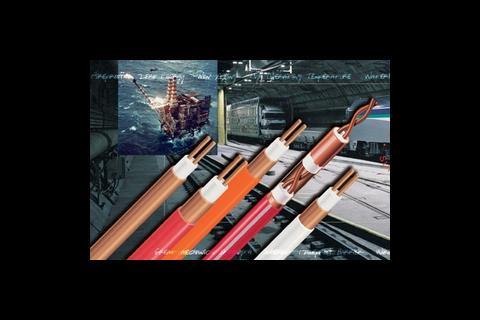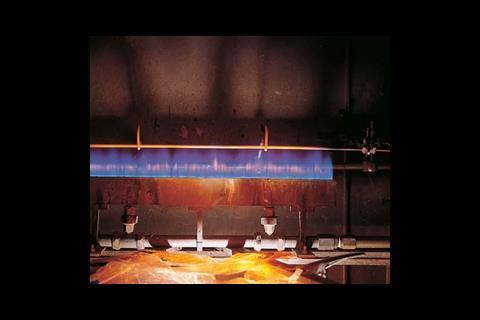This month the cost research department at Davis Langdon Mott Green Wall reviews the principles and practices of life safety electrical services, with particular emphasis on fire-resistant cable types and costs, and with reference to the relevant standards.
Certain building services systems must continue working under fire conditions. Included in the broad range of services are: fire detection and alarms – including voice alerts; emergency escape lighting; sprinkler and wet riser pumps; fire-fighting and evacuation lifts; smoke control fans; pressure relief dampers; motor-driven fire shutters and barriers; and smoke control dampers.
In order to improve the probability of continuous availability, life-safety services are supported by two separate power supplies. For low-power applications such as fire alarms it is practical and cost-effective to provide a single mains supply together with a battery back-up, either integrated into or adjacent to the fire alarm panel. For higher power loads, however, it is impractical to provide the standby supply from a battery. Therefore, two diversely routed circuits are required such that if the normal (or primary) supply fails, then the standby (or secondary) supply should take over automatically.
In these cases the source of energy for the secondary supplies is commonly an auto-start diesel standby generator feeding a “life safety switchboard” installed in dedicated fire-resistant accommodation. Secondary, fire-resistant, supplies are derived from the life safety switchboard for each life-safety service and arranged via an automatic transfer switch (ATS) to take over the duty of a failed primary supply. Such a failure may be due to the effects of a fire, a general mains supply failure to the building, or the mains supply switched off completely or partially by the attending fire brigade.
Implications of the standards
Designers of these systems are faced with a plethora of standards affecting performance and cost. Many large and complex buildings are also fire engineered, which can result in trade-offs between architectural or structural design and life-safety services provision. Most large and complex buildings will have a life safety generator and life-safety switchboard for the distribution of life-safety secondary supplies as described above and as shown in figure 1 (below right).
The treatment of sprinkler pump installations, however, depends on whether or not the Loss Prevention Certification Board (LPCB) Technical Bulletin (TB 22) is followed. TB 22 acknowledges that “It is normal practice for the fire brigade to isolate non-essential supplies when attending a fire”, and recommends that sprinkler pump supplies are taken preferably from the live side of the main intake switchgear. It could be argued that this calls into question the need for fire resistance of the primary supplies to all of the other life-safety services given that they, too, could be switched off or affected by fire, and cause the fire resistant secondary supplies to be switched on. Turning the same argument around, if the primary supply has two hours’ fire resistance and the secondary supply also has two hours’ fire resistance, perhaps that combination will result in a total of four hours and the question then arises as to what fire-fighting activities could still be relevant after such a period.
On the other hand, a detailed look at how all fire-fighting and life-safety supplies are monitored and controlled could well require standards to be applied consistently and more widely. Mains supply monitors on LV switchboards, BMS components and cabling for smoke damper and other controls, ATS equipment and other items of main switchgear are not always protected against fire by design or construction. The piecemeal testing of certain cables to very high standards can prove their performance under those test conditions, but designers should take account of each location and its likely environment under actual fire conditions.
Fire alarm cables
The Code of Practice for Fire Detection and Alarms (BS 5839-1) was revised in 2002 and established the concept of “standard” (30 minutes) and “enhanced” (120 minutes) fire resistance for cables. This market and that for emergency lighting is now stable and well understood, although designers do commonly specify enhanced type cable where the code would suggest that standard fire resistance is adequate – ie, there may be a drift towards inappropriate risk aversion and “play safe”.
The code makes it very clear that standard fire-resistant cable is perfectly adequate for the vast majority of applications; it also describes the situations in which enhanced fire resistance is appropriate. Generally, the enhanced cables are less readily available, are stiffer and therefore more difficult to install, and require more robust containment, fixings and terminations; all of which add to the project cost without necessarily being more fit for purpose.
Power cables
New and emerging standards for fire-resistant power cables have led to some instability in the current market. Historically, mineral-insulated copper-sheathed cables (MICS) were the only option, but in recent years fire-resistant wire-armoured cables have been developed and approved to BS6387 Category CWZ (exposure to fire, water and mechanical impact – albeit with separate test samples).
This type of cable is available from at least three major manufacturers as multi-cores from 1.5 mm2 to 400 mm2 and it has been used widely for at least 10 years in life-safety applications. For ease of reference, for the remainder of this article we shall call this type of cable FP 400.
The new BS7346-6 Components for Smoke and Heat-Control Systems – Part 6, Specification for Cable Systems draws a distinction, for the first time, between the cable survival times for “fire-fighting systems” and “life-safety systems”. Cables serving fire-fighting systems are now required to maintain functionality for 120 minutes under prescribed new test conditions. Those for life-safety and property protection applications have to survive for 30 or 60 minutes depending on the likely consequences of circuit failure. An annexe to the BS suggests which services should survive for which periods.
Unfortunately, very few cables are available that could survive the prescribed test conditions for the fire-fighting applications. Prysmian has developed its FP 600 which achieves the required mechanical protection by means of an interlocking steel-tape armour. But it is only currently available in the limited range from 10 mm2 to 120 mm2; it is stiffer than FP 400 and therefore more difficult to install, and a separate circuit protective conductor is recommended because of the tape-armour characteristics.
Other major cable manufacturers are known to be working on prototypes, but at present it appears only MICS will satisfy the most onerous fire-fighting requirements over the complete range of sizes. Ironically, the success of FP 400 as a flexible, easy-to-install and reasonably priced cable, has had the effect of shrinking the market and the installation skills pool for MICS. MICS is not generally readily available and it is only made as a multi-core up to 25 mm2, above which size single cores need to be installed. The conductors are solid copper, which means that the larger sizes are impossible to bend by hand, and not all electricians have the necessary skills to plan, install and terminate these cables in a satisfactory manner.
Consequently, it is concluded from recent research that FP 600 installations, where they can be compared directly with FP 400 installations, are likely to cost between 1.5 and 1.9 times more with the higher differentials applying to the larger cable sizes. MICS installations, where they can be compared directly with FP 400 installations, are likely to cost between 1.8 and 2.9 times more for the four-core cables, and approximately four times more for the multiple singles MICS-type installations, ie 35 mm2 and above.
In conclusion, there is a concern that designers and contractors will err on the side of caution, or will not bother, or will not be able, or consider it not worthwhile, to differentiate between the cable types for:
- services that may be used for fire-fighting
- those that are “just for life-safety” services
- life-safety services to survive either for 30 or 60 minutes.
Table 1 notes
The cost model sets out to assess the practical implications of the standards. The hypothetical building has a gross internal area of 10,000 m2 over 10 floors, with one financial services or dealer-type tenant per floor. The fire strategy includes for phased evacuation. A single life-safety generator and life-safety switchboard are located in a rooftop plant room. The designer has taken account of the latest standards, and decided that cables feeding the fire-fighting lift, the sprinkler pumps, and the smoke or heat exhaust ventilation systems are all required to survive for 120 minutes.
The cost impact may be considered modest, but tall and complex buildings are likely to require much larger sub-mains, with MICS singles or possibly multiple FP 600s in parallel.
Exclusions:
- Containment, terminations and separate CPCs
- Site organisation and management costs other than specialist contractor’s allowances
- Contingency/design reserve
- Main contractor’s overhead and profit or management fee
- Professional fees
- Tax allowances
- Value added tax
- Inflation beyond first quarter 2007
Downloads
Source
Building Sustainable Design
Postscript
Mott Green Wall is grateful to Hilson Moran for assistance in researching the schedules of rates used in the cost model
























No comments yet